
Bundled up, frosty breath clouding the air — don’t think the big biters won’t show themselves during winter’s chill. It’s not easy and you have to play their game, but as our Elite experts explain, a giant bite may be waiting at the end of your next cast. Here’s a handful of suggested tactics.
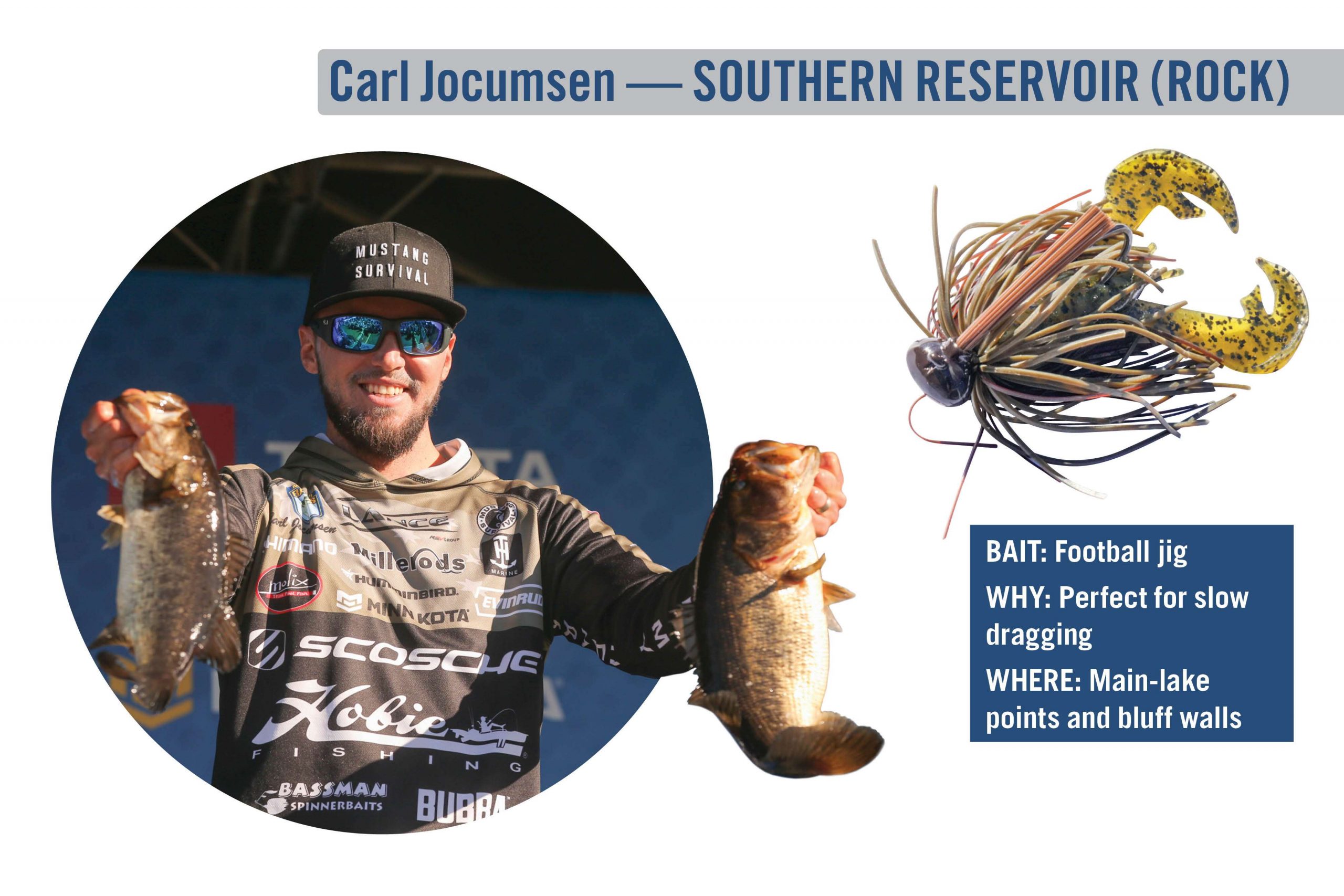
Carl Jocumsen — SOUTHERN RESERVOIR (ROCK)
Ask the Aussie pro his opinion of winter fishing and he’ll tell you it’s a drag — in the best sense of the word. In his experience, it’s hard to beat the meticulous presentation of a big jig.
His preference: a 1/2-ounce Molix Football (MF) jig that features a “bi-round” tungsten head that’s a kind of football/flipping jig hybrid dressed with a fine-cut, mop-style silicone skirt and fit with a wide gap hook. Calling this jig the right tool for the job, Jocumsen said the key is low and slow.
“That style head comes through rock, brush and about anything you throw it at,” Jocumsen said.
Jocumsen starts with a Strike King Rage Craw trailer, but if the fish aren’t feeling it, he switches to a toned-down, full-size chunk trailer. Acknowledging that the latter more closely fits conventional wisdom, Jocumsen said the look is often the key to triggering big bites from big fish that are actively looking for a winter meal.
“You hear a lot of guys talk about using a chunk in winter, but some of my best bites have come on a jig with a pretty aggressive tail,” he said. “I want the tail to give off vibration when it falls, but what I’m doing is I’m literally counting rocks, crawling it.
“Some of my best tournament finishes, some of my best fun-fishing days, some of the biggest fish I’ve caught have come on a jig that time of year. When I say I’m counting rocks, that’s literally what I’m doing; it has to be so subtle, and you’re letting it glide over one rock to the next.”
Jocumsen employs his slow-dragging technique over main-lake points and bluff walls leading into spawning areas. Points, he said, are prime staging areas for early prespawners, while bluff walls serve as travel lanes with vertical depth options. Points with brush are golden.
Riprap walls also come into play. While he makes long presentations to points and bluffs, Jocumsen uses shorter casts to riprap to maintain a higher line angle and minimize crevice wedging.
Favoring a green pumpkin trailer sprayed with Fish Bomb crawfish scent, Jocumsen follows a disciplined color plan: chartreuse tips, plain, then orange tips — especially if he sees regurgitated craws with orange claw tips. Fish response dials in the day’s preference, but his logic is solid.
“What I like about chartreuse is that the fish mistake it for bluegill, as well as crawdads,” he said. “There’s just something about chartreuse tips that fish just generally like.
“If I’m on that jig bite, I’ll rotate through all of those colors and keep showing them something different, especially if I’m going down the same riprap wall or fishing the same rockpile. You’ll see the bite die off and then pick back up again when you give them a tiny bit of change.”
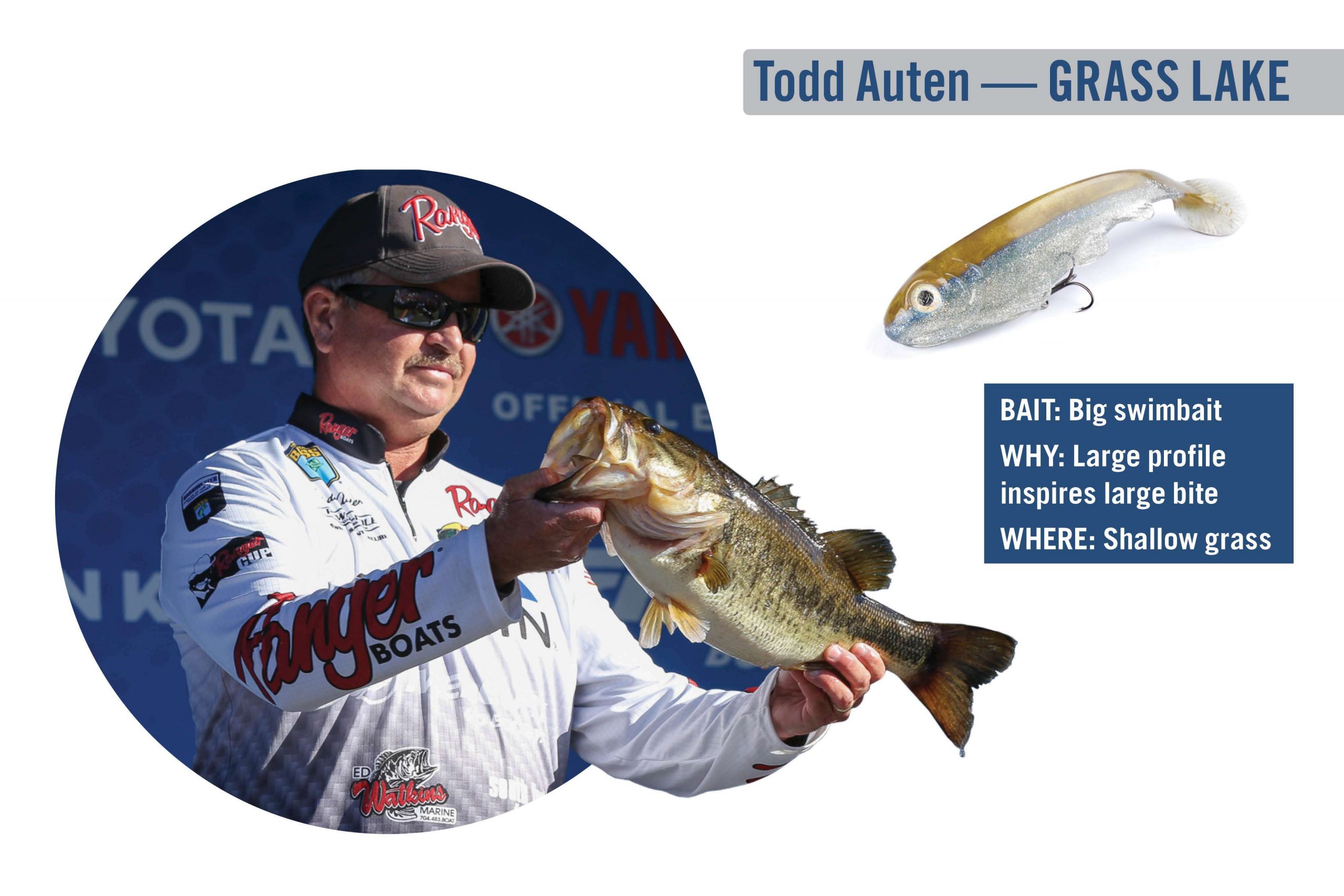
Todd Auten — GRASS LAKE
The South Carolina pro believes he’ll earn his best shot at tempting a winter giant by slow rolling a big swimbait over the vegetation. Auten likes the 7-inch Osprey Talon, a nose-weighted bait with an in-line channel that allows him to feed his 25-pound fluorocarbon through and attach a 3X Owner treble below.
“I like the large profile and the ability to wind the bait slow for a winter bite,” Auten said. “I’ll throw this bait on the points of grass and the outside edges, usually somewhere near deeper water.
“I’d be throwing this around grass in 2 to 5 feet on the flats near a channel swing where fish are moving up to feed. If I’m fishing right in the grass, I like the braid, but I prefer fluorocarbon because it helps keep the bait down.”
Lobbing his swimbait on a 7-7 G.Loomis IMX-PRO heavy rod, Auten winds with a 6.2:1 Shimano 200 Curado reel. The lower speed, he said, best serves the big-bait presentation by providing more torque and thereby reducing fatigue.
“It’s pretty much cast and wind, but the retrieve speed is what you have to figure out — whether they want it faster and higher, or slower and a little bit lower,” Auten said. “It’s usually higher on cloudier days and lower on sunny days.”
Prefront and postfront conditions play a big role in depth preferences, and the latter may occasionally require Auten to reach into deeper retreats. When this need arises, or if his bait is rolling, he inserts tungsten nail weights into the bait’s belly for stability and/or greater sink rate.
“Early mornings and late in the evening would be the best times for the big fish bite,” Auten said. “For the morning or evening feed, they’ll come in and move up on that flat, but they might also come up during a [warming trend] when the bait gets active.
“I tend to lean more toward the evening because that fish wants to get one more big snack before he goes to bed,” Auten said. “When one eats the bait, you have to let them take it a little bit. I let the rod load up and just pull into it.”
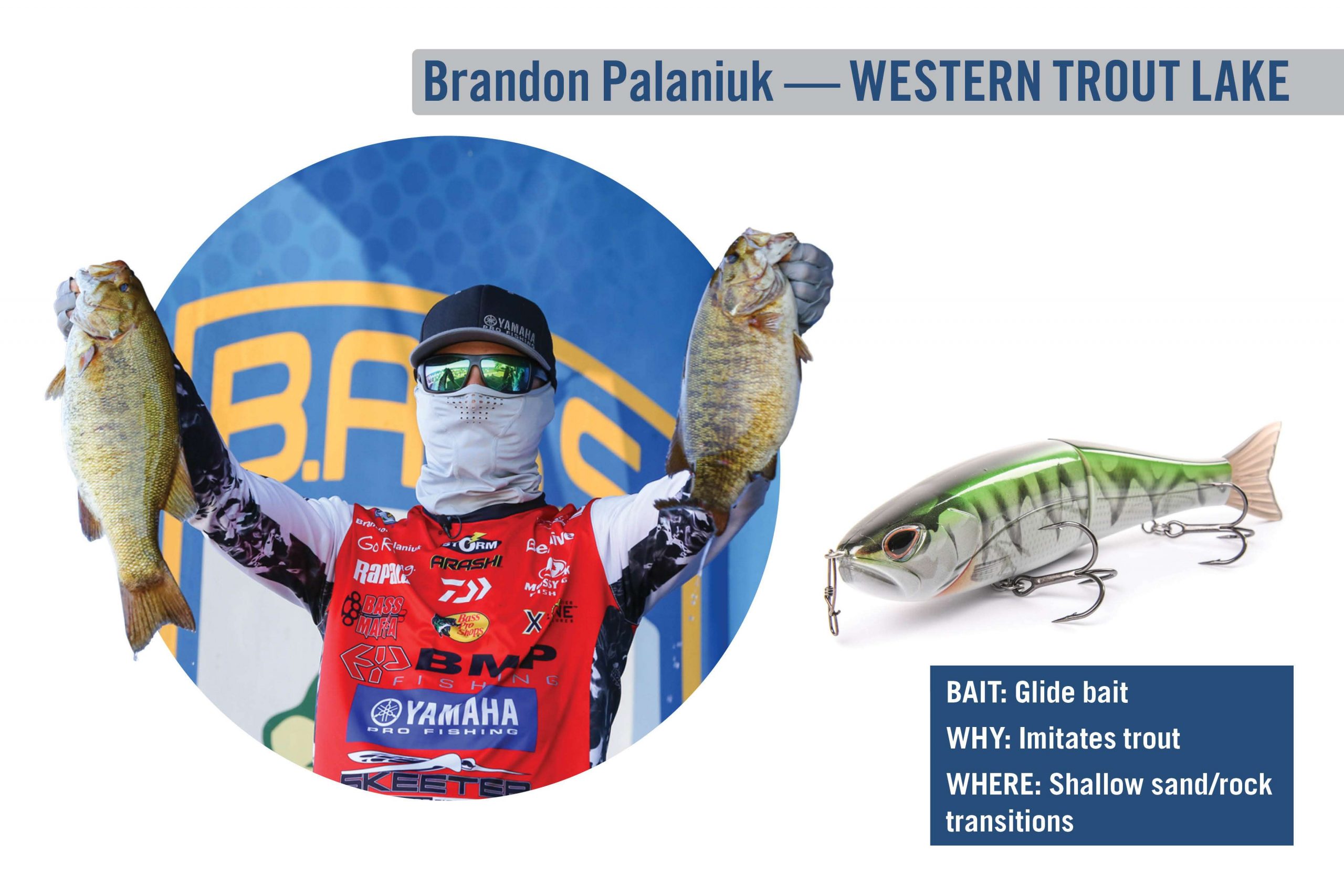
Brandon Palaniuk — WESTERN TROUT LAKE
Adhering to the simplest rule of fishing — follow the food — Palaniuk does his best to infiltrate the forage by targeting big bass looking to score a mouthful of rainbow trout. On waters like Lake Havasu, Diamond Valley Lake, Canyon Lake and Clear Lake, he finds that the daily buffet presents an irresistible feeding opportunity for winter-weary fish that value big-meal efficiency.
“This is a really good time to go through your larger swimbaits, like a Storm Arashi Glide or an 8-inch Huddleston swimbait,” Palaniuk said. “Trout are a cold-water species, so when those waters cool, a lot of times, you’ll find they’ll move from that deep water to shallower and run the bank.”
Palaniuk looks for sand/rock transitions with deep-water access. Proximity to this depth security is important for predator and prey, as it allows them to drop off the edge and flee danger and/or weather changes.
“It could be a long, tapering point that has a steep drop on one side; if the body of water has bluff walls, where those bluff ends transition into sand can be really good places,” he said. “It could even be something as simple as a drain in the middle of that bluff wall where silt has washed out over the years.
“Those scenarios can create good ambush areas. When you’re looking for one big bite, you don’t have to have a giant, expansive area.”
Favoring the Arashi Glide, Palaniuk said a slow and steady retrieve allows the bait to move without anything too spirited. This, he said, mimics the trout’s generally ambling ways, but there will definitely be a time for the panicked look.
“If you have a bass follow, if that fish is right on the bait, sometimes one quick, erratic twitch will get them to trigger,” Palaniuk said. “Most of the time, I want to bring my bait from deeper to shallower water because that’s going to force those fish to commit.”
Palaniuk likes the rainbow trout color under cloudy skies, while ghost rainbow works best in sunny conditions. One modification: For a slower sink rate and a suspending presentation, he’ll downsize his treble hooks.
“A lot of times, you’ll see the bite happen,” Palaniuk said. “You have cleaner water that time of year; a lot of times, they’ll follow [the bait] and eat [it] close to the boat. The biggest thing is [to] allow the fish to get to the boat.
“If it does happen right at the boat, you don’t have to set the hook as hard as you possibly can. You just have to reel into them until you feel the pressure and then lean.”
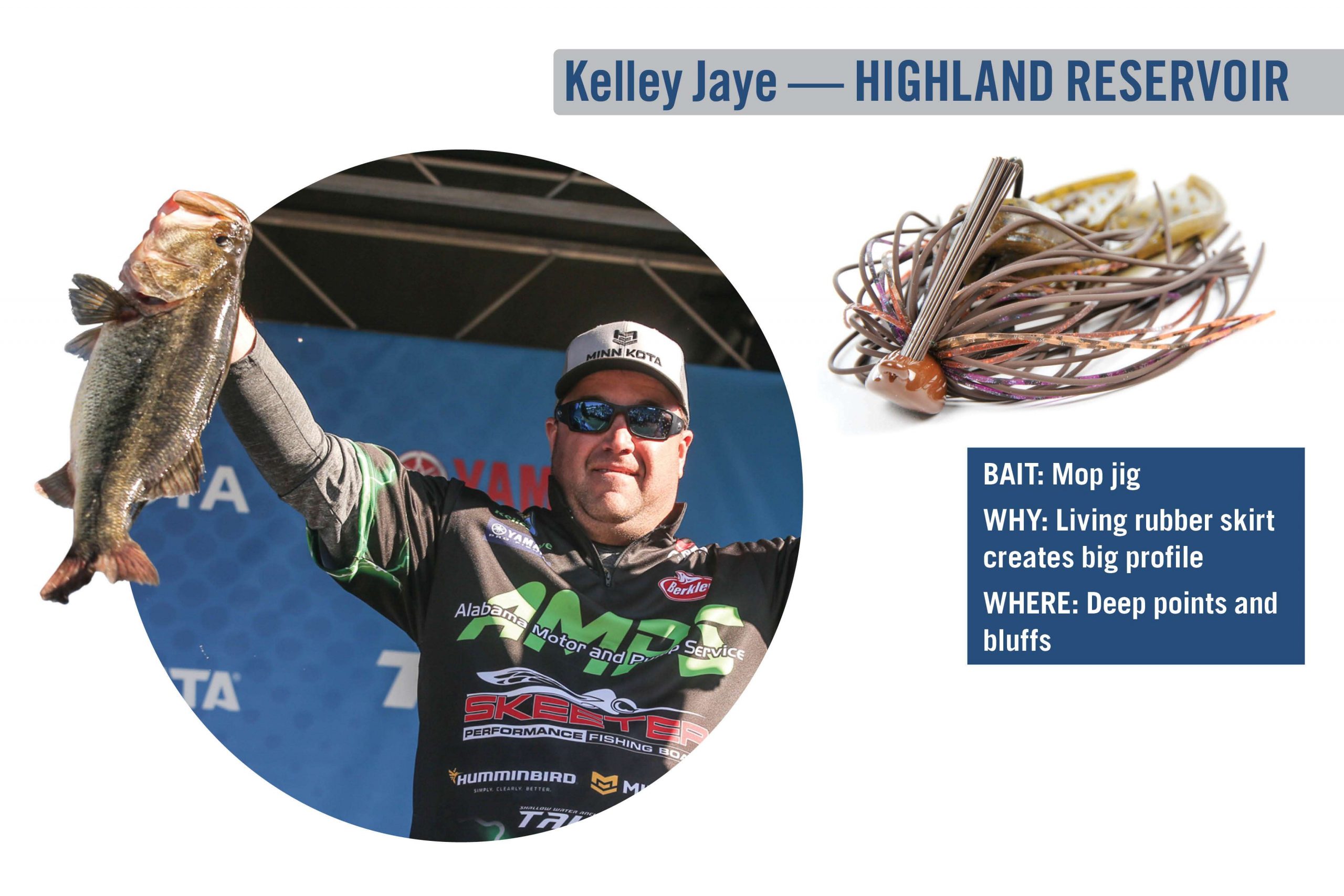
Kelley Jaye — HIGHLAND RESERVOIR
Jaye loves throwing his jerkbait in that deep, clear water, but he knows it’s typically not a giant-getter. That’s why he stows the reaction bait and puts his faith in a brown mop jig with a green pumpkin chunk trailer — a large profile that fits the fish’s dietary plans.
“When the water’s cold, the fish’s metabolism is so low that they don’t have to eat a lot; they can live off one good-size shad for four days,” he said. “Those big fish, especially, are really lethargic. They don’t want to expend any energy, so that mop jig just looks like a big meal.”
Noting how he avoids anything that looks like it might run away from a shivering fish, Jaye said he prefers the Berkley PowerBait MaxScent Chunk for its subtle profile. Designed with bunny ear appendages, the trailer completes a package that matches a prominent forage option.
“That color combination is old school and it always gets bit,” Jaye said. “Clear water, stained water — they bite it because crawfish tend to have those colors [on their shell] in those lakes.”
Jaye does most of his work with a 1/2-ounce jig, but he’ll go up to 3/4 if he’s working in 25 feet or more. Deep points and bluffs are his top targets this time of year, as he’s hoping to intercept fish positioning ahead of their spawning movement.
“I would make kind of a roll cast at the bank; I wouldn’t make long casts with a football jig,” Jaye said. “I would make a 25- to 30-foot cast and pull it down the point or off the bluff wall. I wouldn’t hop it or anything — just pull it really slow with steady contact to the bottom.
“On a bluff, I want to cover everything from the bank to where it drops off. In the spring, you usually key in on certain depths where the fish are really active and you concentrate on that depth and parallel the bank. But this time of year, you don’t know what depth the fish will be in, so I want to make as many casts as I can in a productive zone.”
Jaye trims his weedguard at a 45-degree angle back to his hook point. Running his finger over the fibers, he wants to make sure he can easily feel the hook point.
“If I feel a bite, I let them load up, drop the rod tip, make sure they’re on there and then bring it home,” Jaye said. “I don’t let them swim around with it too long.”
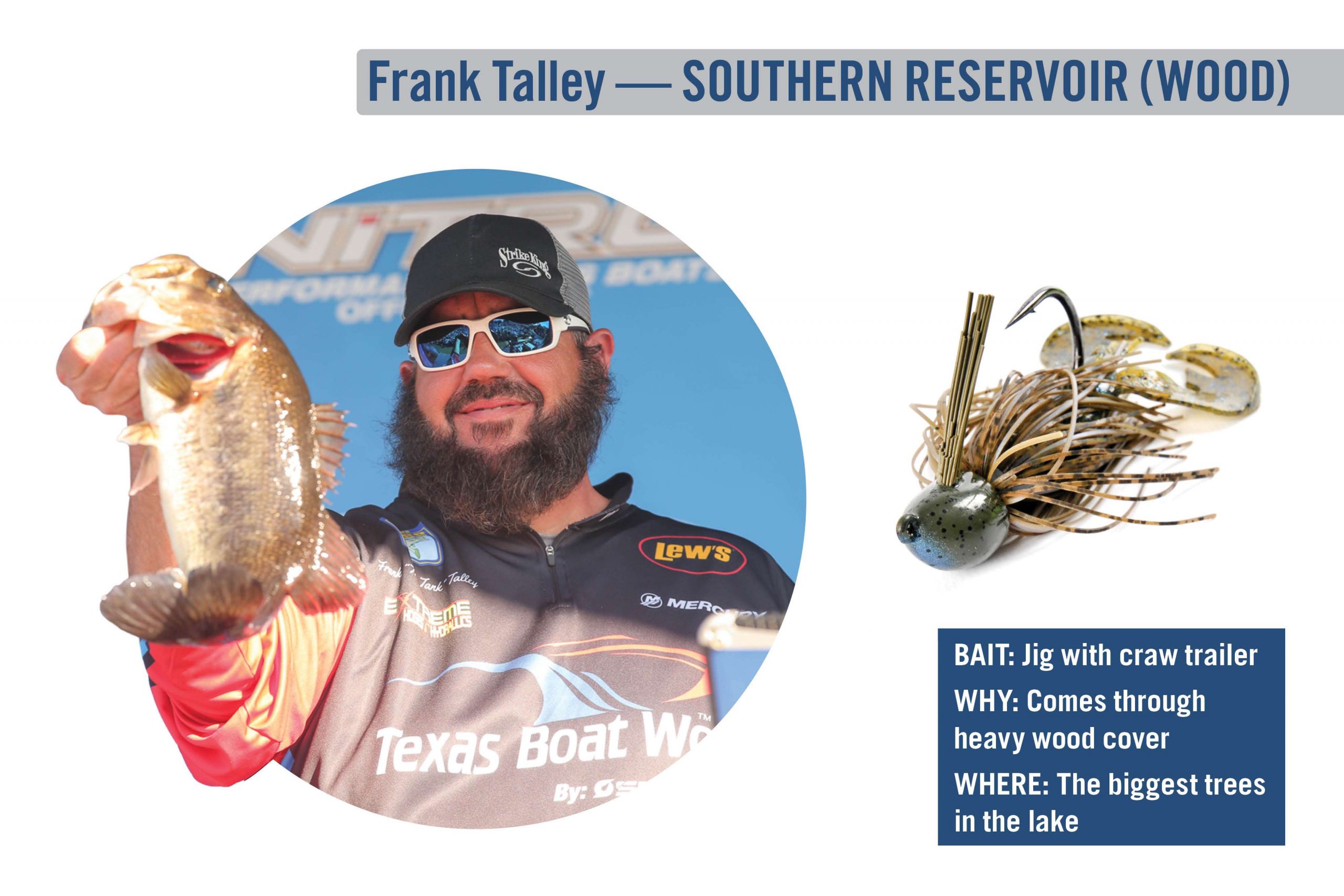
Frank Talley — SOUTHERN RESERVOIR (WOOD)
Give Talley a 1/2-ounce Strike King Hack Attack flipping jig with a Strike King Rage Craw and he’s good to go. Black and blue is his go-to color, but when facing higher winter clarity, he’ll use green pumpkin or watermelon.
“I’m definitely going to flip an isolated piece of timber,” Talley said. “In my opinion, those big fish only feed that time of year maybe once every other day. You want to present a big offering to them so they don’t have to exert a lot of energy chasing after it.
“Flipping something down on a piece of cover where they’re holding, they see a big mouthful falling down to them. Being a full meal, they’re more apt to eat it, versus [retrieving] something smaller by them, like a small crankbait or spinnerbait, where they have to exert energy to chase it.”
To minimize his bait’s profile and allow it to smoothly traverse cover, Talley cuts two segments off the top of the Rage Craw so the pincers hang just below the hook bend. Trimming the skirt within a quarter-inch of the hook bend furthers this objective. Lastly, Talley clips four strands off the weedguard’s underside to thin the mass and improve hook penetration.
“The right piece of cover will be bigger than any other timber around it — the diameter of the tree’s going to be bigger,” Talley said. “If you have a bunch of 5-gallon-bucket-size pieces of timber and then you have a 55-gallon-drum piece of timber, that bigger piece of cover is what you want to target.
“A saying to live by is: the bigger the tree, the bigger the fish. That really holds true in Texas and a lot of the Southern states. Those fish like to get on something big.”
Talley points out that, while a big tree definitely holds the warmth winter bass see, it’s also a shade thing. A prominent piece of structure offers significant shade on both sides of high noon.
“Even though it’s wintertime and you’d think they’d want to be up there sunning themselves, they still want to sit back in the shade because they’re predators,” Talley said. “The first part of the morning, they’re on one side of the tree, and that afternoon, they’ll be on the opposite side.”
Originally appeared in Bassmaster Magazine 2021.





